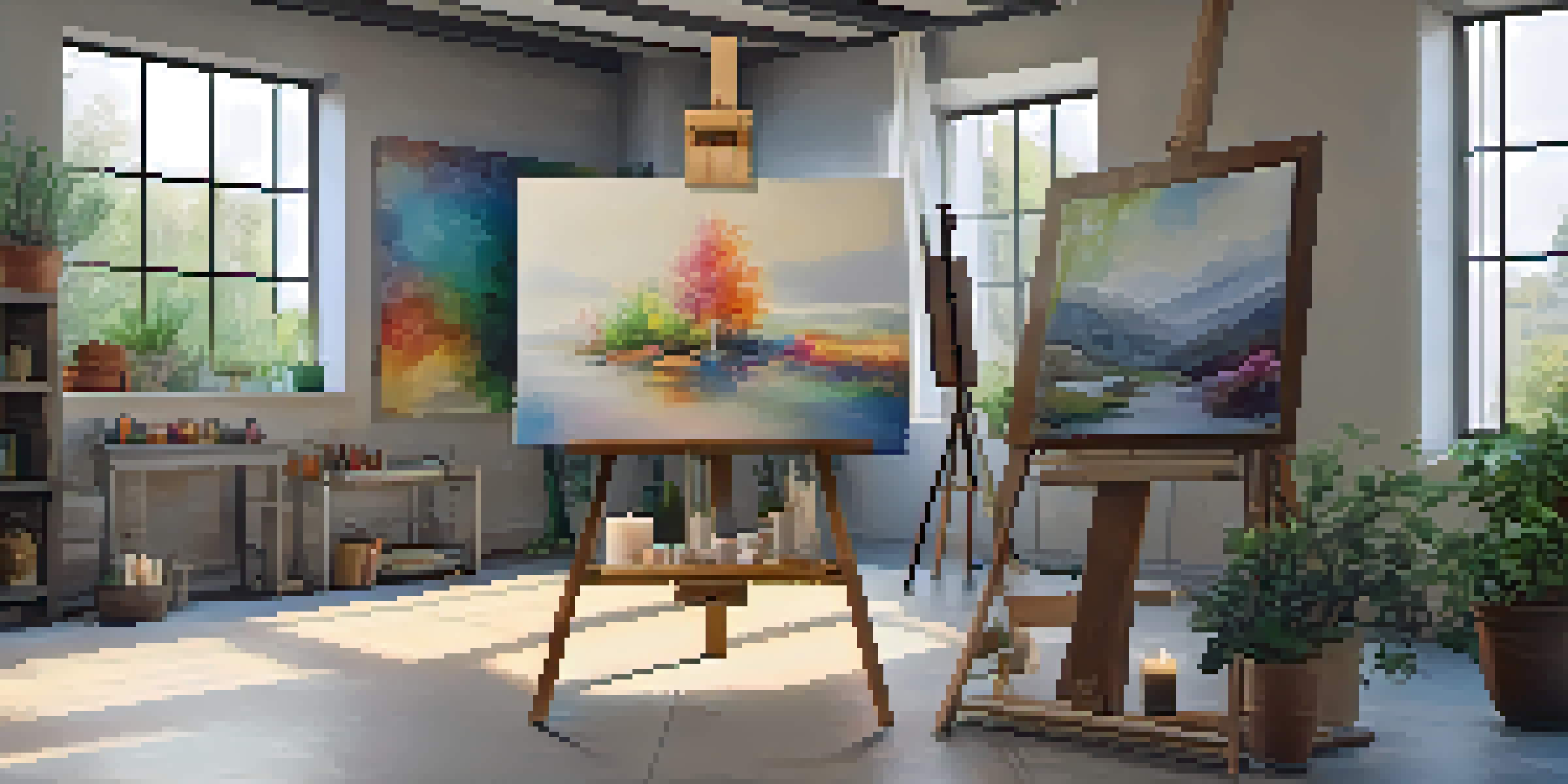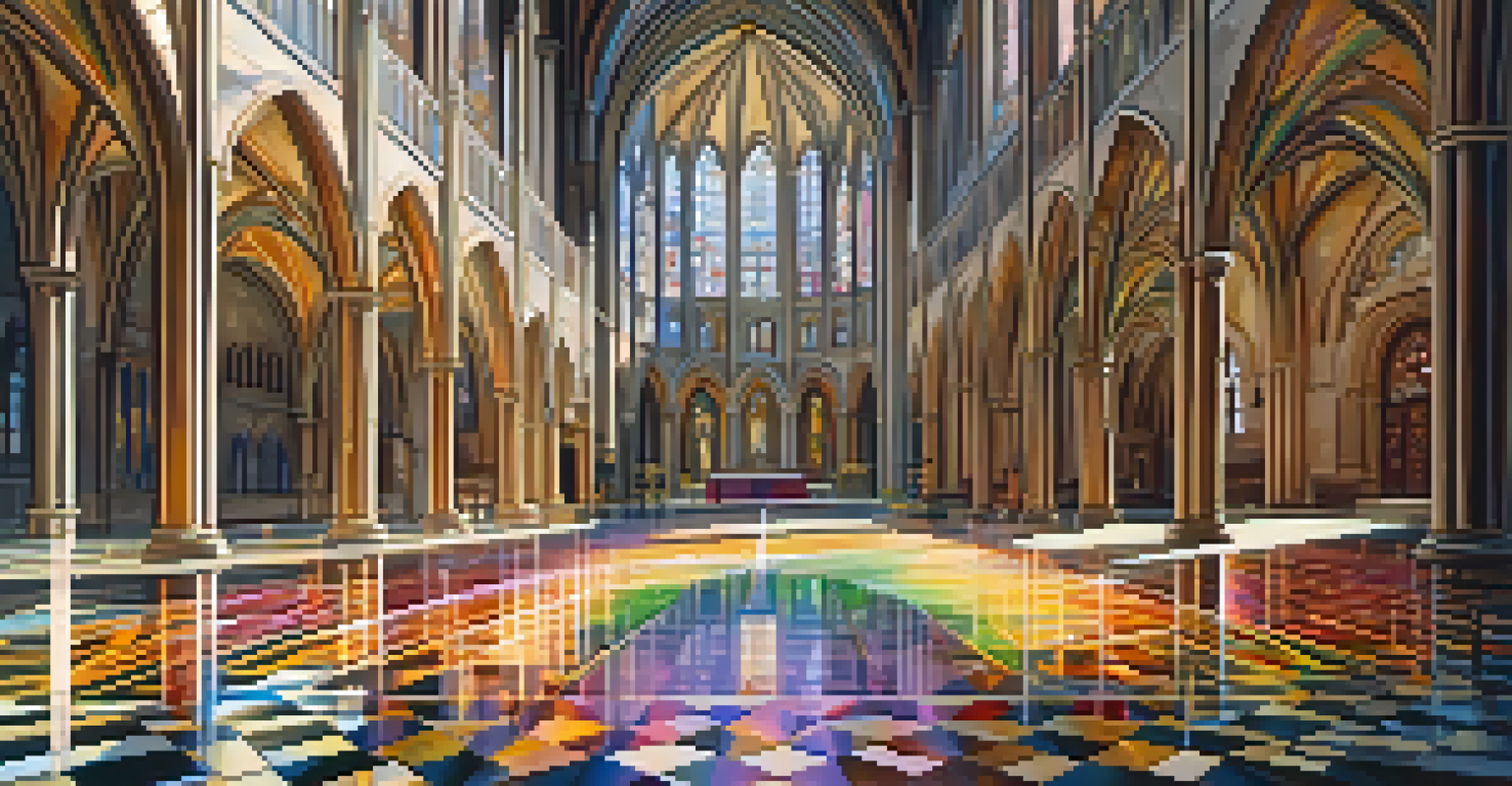Sacred Spaces: The Intersection of Art and Spirituality

Understanding Sacred Spaces in Art and Spirituality
Sacred spaces are environments that foster a deep connection to the divine, often enhanced by art. These spaces can be physical places, like temples or cathedrals, but they can also be conceptual, bringing together emotional and spiritual experiences. Art serves as a conduit, allowing individuals to explore their spirituality through various forms of expression, from painting to sculpture.
Art is the most beautiful of all lies.
Imagine walking into a grand cathedral, where stained glass filters sunlight into vibrant colors. This visual experience not only captivates the eye but also uplifts the spirit, showcasing how art can transform a physical space into something sacred. The interplay between the space and the artwork can evoke feelings of awe, reflection, and tranquility.
Through this lens, we can see that art isn't merely decorative; it's a vital part of how we experience and understand spirituality. Whether it’s a serene landscape painting that inspires contemplation or an abstract sculpture that invites questioning, art can help bridge the gap between the material and the spiritual realms.
Historical Context: Art as a Spiritual Practice
Throughout history, art has played a significant role in religious and spiritual practices. From ancient cave paintings that depict rituals to the intricate designs of Islamic architecture, artists have used their skills to express beliefs and values. These works often served not only as decoration but as a means to communicate the divine.

Consider the Renaissance period, when artists like Michelangelo and Raphael infused their work with spiritual narratives. Their masterpieces were not just artistic endeavors but also reflections of their deep faith and understanding of spirituality. This historical context underscores how art has always been intertwined with the human experience of the sacred.
Art Enhances Spiritual Connection
Sacred spaces, whether physical or conceptual, are enriched by art, allowing individuals to explore and deepen their spirituality.
As we trace the lineage of art in spiritual contexts, we see a consistent thread: the desire to connect with something greater than ourselves. This connection can manifest in various forms, from religious iconography to contemporary installations that challenge our perceptions of the divine.
Modern Expressions of Sacred Art
In today's world, artists continue to explore the intersection of art and spirituality, often pushing boundaries and challenging traditional norms. Modern artists may draw inspiration from diverse spiritual practices, blending cultural influences to create pieces that resonate on multiple levels. This approach allows for a more inclusive understanding of spirituality.
Art is a spiritual act, a process that can lead us to the divine.
For instance, contemporary installations may incorporate elements from nature, inviting viewers to engage with their surroundings in new ways. These works can evoke a sense of peace and reflection, encouraging a deeper connection to both the artwork and the environment. The use of organic materials or immersive experiences transforms spaces into modern sacred spaces.
Moreover, the digital age has opened up new avenues for spiritual expression. Virtual galleries and online art communities allow individuals to share their interpretations of spirituality through art, fostering a global dialogue that transcends geographical boundaries. This evolution highlights how art remains a vital part of our quest for understanding and connection.
The Role of Ritual in Artistic Creation
Rituals have long been a part of artistic creation, serving as a way to channel creativity and invoke spiritual energy. Artists often engage in personal or cultural rituals before or during the creative process, whether it's meditation, prayer, or simply setting a specific intention. These practices can help ground the artist, allowing for a deeper connection to their work.
Think of a potter who begins each session with a moment of silence, focusing on their breath before shaping the clay. This simple act not only centers the artist but also infuses the creation with intention and mindfulness. Such rituals can elevate the act of making art into a spiritual practice, adding layers of meaning to the final piece.
Rituals Elevate Artistic Creation
Engaging in personal or cultural rituals during the artistic process infuses creativity with intention and spiritual energy.
Furthermore, these rituals can resonate with viewers, inviting them to experience the artwork in a more profound way. When the audience senses the intention behind a piece, it transforms their interaction, making it feel more sacred and personal.
Art as a Medium for Spiritual Exploration
Art provides a unique platform for individuals to explore and express their spiritual beliefs. Through various mediums, artists convey their personal journeys, struggles, and revelations, offering viewers a glimpse into their inner worlds. This exploration fosters an environment where spirituality can be questioned, celebrated, or even challenged.
For example, a mixed media piece that incorporates text, images, and found objects may reflect the artist's spiritual struggle. This layered approach invites the audience to engage with the complexities of spiritual life, encouraging dialogue and personal reflection. Art becomes a mirror, reflecting both the artist's and the viewer's experiences.
Moreover, such pieces can serve as a catalyst for personal growth, prompting individuals to confront their own beliefs and values. In this way, art is not just a representation of spirituality; it becomes a transformative tool that inspires self-discovery and deeper understanding.
Community and Collective Spiritual Experiences
Sacred spaces often foster community, bringing people together to share in artistic and spiritual experiences. Whether through collaborative art projects or communal rituals, the act of creating together can strengthen bonds and deepen connections. This sense of community can be incredibly powerful, as it allows individuals to explore spirituality in a supportive environment.
Consider a community mural project where local artists and residents gather to express shared values and beliefs. The process itself becomes a sacred act, as participants collaborate to create something meaningful. This collective experience not only beautifies the neighborhood but also cultivates a sense of belonging and shared purpose.
Community Strengthens Spiritual Bonds
Collaborative art projects create sacred experiences that foster community, allowing individuals to explore spirituality together.
Additionally, these communal experiences can transcend individual differences, fostering understanding and acceptance. By coming together to create, people can celebrate their diverse spiritual paths while recognizing the common threads that unite them, reminding us that we are all part of something larger.
Finding Personal Sacred Spaces through Art
Ultimately, sacred spaces can be personal as well as communal, with each individual finding their own unique connection to art and spirituality. For some, this may be a quiet corner of a gallery; for others, it could be a home altar filled with meaningful objects and artworks. These personal sacred spaces invite introspection and offer solace in an often chaotic world.
Imagine creating a small art studio in your home, where you can paint, sculpt, or meditate. This space becomes a sanctuary, allowing you to explore your creativity and spirituality at your own pace. The act of crafting your own sacred space can be a deeply fulfilling journey, one that encourages you to connect with your inner self.

As you cultivate these personal spaces, you may find that your relationship with art and spirituality deepens. Each brushstroke or sculpted form becomes a reflection of your journey, inviting you to explore your beliefs, values, and experiences in a meaningful way.